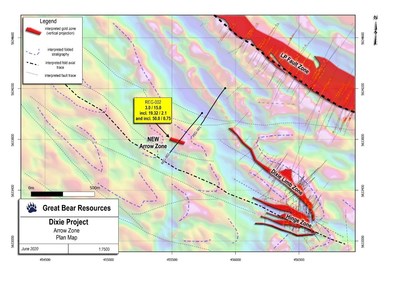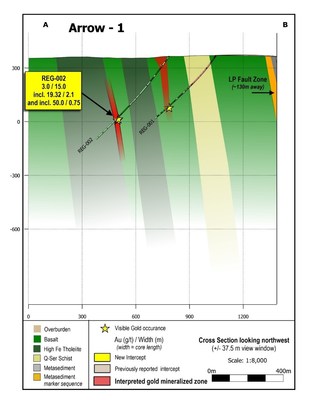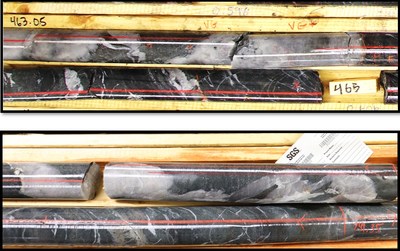Great Bear Discovers New High Grade "Arrow" Zone: 19.32 g/t Gold Over 2.10 m, Within 3.00 g/t Gold Over 15.00 m
TSX-V: GBR
VANCOUVER, BC, June 18, 2020 /CNW/ - Great Bear Resources Ltd. (the "Company" or "Great Bear") (TSXV: GBR) (OTCQX: GTBAF) today reported results from its ongoing fully funded $21 million exploration program at its 100% owned flagship Dixie Project in the Red Lake district of Ontario.
Chris Taylor, President and CEO of Great Bear said, "Targeted regional drilling has repeated the success of our original Hinge zone discovery of 2018, one kilometre west of the Hinge zone. Drill hole REG-002 intersected three zones of gold mineralization including a 15 metre wide interval containing high-grade visible gold in quartz veins, the "Arrow" zone. These new gold-bearing veins have the same high temperature red-brown hydrothermal biotite alteration that is characteristic of the Hinge zone veins at Dixie, and the High Grade Zone at the Red Lake Gold Mine. While our primary focus remains the ongoing grid drilling program at the LP Fault zone, systematic follow up drilling of the Arrow discovery is clearly required, and additional regional targets also need to be drilled. The discovery of an additional Red Lake style high-grade gold zone in the first new area we've tested this year supports the strong ongoing discovery potential of the Dixie project."
Drill hole locations and results are provided in Figure 1, and in Table 1, respectively.
Drill Results Highlights:
New drill hole REG-002 was completed 1.2 kilometres to the west-northwest of the Hinge zone. Highlights include:
- 19.32 g/t gold over 2.10 metres, including 50.00 g/t gold over 0.75 metres, within a broader interval of 3.00 g/t gold over 15.00 metres. Figure 2, Figure 3, Figure 4 and Figure 5.
- Three mineralized intervals were intersected along 435.55 metres of core length.
- Gold mineralization was present at significant changes in rock type. In particular, high-grade gold within quartz veins was best developed at the contact between a high iron tholeiitic pillow basalt and a massive basalt. This is the same type of geological contact that is highly mineralized at the Hinge and Dixie Limb zones, however the Arrow zone occurs at a different stratigraphic position.
- The Arrow zone veins strike 280 degrees and dip steeply to the northeast, similar to the Hinge zone veins. The regional D2 fold axis that is adjacent to the Hinge, Dixie Limb and Arrow zones extends for approximately 3.7 kilometres to the west-northwest from the Hinge Zone, before being terminated by a granitic batholith. The Arrow zone marks the westernmost drilling along this trend to date.
New drill hole REG-001 was completed to the northeast of RE-002 on the same drill fence. It intersected anomalous mineralization returning 0.51 g/t gold over 2.20 metres.
Oriented structural data suggests the mineralized interval in REG-001 is the same mineralization intersected at the top of drill hole REG-002 (1.09 g/t gold over 1.00 metres and 1.80 g/t gold over 1.30 metres), as shown on Figure 2. The vertical distance between the upper intercepts in REG-002 and REG-001 is approximately 300 metres. These results suggest significant potential vertical continuity in the Arrow zone, as has been observed at the other zones across the Dixie property.
The Arrow zone was targeted by projecting established gold mineralization trends observed within the LP Fault, Dixie Limb and Hinge zones along strike into the discovery area. While all three of these zones exhibit different geological controls and alteration signatures, they also all have a population of quartz veins with an approximately east-west orientation which often contain high-grade gold. The trends from the three zones intersect in several areas (Figure 1) near the Arrow zone and for this reason two exploratory drill holes were completed to cross two of these projected trends, resulting in the new discovery.
The Company notes that the Arrow zone discovery is the first confirmed occurrence of high-grade quartz veins with red-brown hydrothermal biotite alteration observed outside of the Hinge zone at Dixie. This type of high temperature alteration is a key characteristic of the High Grade Zone discovery at the Red Lake Gold Mine, initially made by Goldcorp Inc.; the mine is now operated by Evolution Mining Ltd. Other regional gold bearing quartz veins at Dixie such as those observed in the North Fault target contain accessory tourmaline gangue mineralogy which is characteristic of later-stage, lower temperature gold mineralization across the Red Lake district.
Table 1: Current drill results. REG-002 intersected the new Arrow zone.
Drill Hole | From (m) | To (m) | Width* (m) | Gold (g/t) | |
REG-001 | 414.10 | 416.30 | 2.20 | 0.51 | |
REG-002 | 28.10 | 29.10 | 1.00 | 1.09 | |
and | 81.00 | 82.30 | 1.30 | 1.80 | |
and | 451.50 | 466.50 | 15.00 | 3.00 | |
including | 459.00 | 465.00 | 6.00 | 7.03 | |
and including | 462.90 | 465.00 | 2.10 | 19.32 | |
and including | 462.90 | 463.65 | 0.75 | 50.00 |
* | Widths are drill indicated core length, as insufficient drilling has been undertaken to determine true widths at this time. Average grades are calculated with un-capped gold assays, as insufficient drilling has been completed to determine capping levels for higher grade gold intercepts. Average widths are calculated using a 0.10 g/t gold cut-off grade with up to 3 m of internal dilution of zero grade. |
Drill collar locations, azimuths and dips for the drill holes included in this release are provided in the table below:
Hole ID | Easting | Northing | Elevation | Dip | Azimuth |
REG-001 | 455916 | 5634199 | 368 | -55 | 220 |
REG-002 | 455737 | 5634007 | 364 | -55 | 220 |
About the Dixie Project
The Dixie Project is 100% owned, comprised of 9,140 hectares of contiguous claims that extend over 22 kilometres, and is located approximately 25 kilometres southeast of the town of Red Lake, Ontario. The project is accessible year-round via a 15 minute drive on a paved highway which runs the length of the northern claim boundary and a network of well-maintained logging roads.
The Dixie Project hosts two principle styles of gold mineralization:
- High-grade gold in quartz veins and silica-sulphide replacement zones (Dixie Limb, Hinge and Arrow). Hosted by mafic volcanic rocks and localized near regional-scale D2 fold axes. These mineralization styles are also typical of the significant mined deposits of the Red Lake district.
- High-grade disseminated gold with broad moderate to lower grade envelopes (LP Fault). The LP Fault is a significant gold-hosting structure which has been seismically imaged to extend to 14 kilometres depth (Zeng and Calvert, 2006), and has been interpreted by Great Bear to have up to 18 kilometres of strike length on the Dixie property. High-grade gold mineralization is controlled by structural and geological contacts, and moderate to lower-grade disseminated gold surrounds and flanks the high-grade intervals. The dominant gold-hosting stratigraphy consists of felsic sediments and volcanic units.
About Great Bear
Great Bear Resources Ltd. is a well-financed gold exploration company managed by a team with a track record of success in mineral exploration. Great Bear is focused in the prolific Red Lake gold district in northwest Ontario, where the company controls over 300 km2 of highly prospective tenure across 4 projects: the flagship Dixie Project (100% owned), the Pakwash Property (earning a 100% interest), the Dedee Property (earning a 100% interest), and the Sobel Property (earning a 100% interest), all of which are accessible year-round through existing roads.
QA/QC and Core Sampling Protocols
Drill core is logged and sampled in a secure core storage facility located in Red Lake Ontario. Core samples from the program are cut in half, using a diamond cutting saw, and are sent to Activation Laboratories in Ontario, an accredited mineral analysis laboratory, for analysis. All samples are analysed for gold using standard Fire Assay-AA techniques. Samples returning over 10.0 g/t gold are analysed utilizing standard Fire Assay-Gravimetric methods. Pulps from approximately 5% of the gold mineralized samples are submitted for check analysis to a second lab. Selected samples are also chosen for duplicate assay from the coarse reject of the original sample. Selected samples with visible gold are also analyzed with a standard 1 kg metallic screen fire assay. Certified gold reference standards, blanks and field duplicates are routinely inserted into the sample stream, as part of Great Bear's quality control/quality assurance program (QAQC). No QAQC issues were noted with the results reported herein.
Qualified Person and NI 43-101 Disclosure
Mr. R. Bob Singh, P.Geo, Director and VP Exploration, and Ms. Andrea Diakow P.Geo, Exploration Manager for Great Bear are the Qualified Persons as defined by National Instrument 43-101 responsible for the accuracy of technical information contained in this news release.
ON BEHALF OF THE BOARD
"Chris Taylor"
Chris Taylor, President and CEO
Cautionary note regarding forward-looking statements
This release contains certain "forward looking statements" and certain "forward-looking information" as defined under applicable Canadian and U.S. securities laws. Forward-looking statements and information can generally be identified by the use of forward-looking terminology such as "may", "will", "should", "expect", "intend", "estimate", "anticipate", "believe", "continue", "plans" or similar terminology. The forward-looking information contained herein is provided for the purpose of assisting readers in understanding management's current expectations and plans relating to the future. Readers are cautioned that such information may not be appropriate for other purposes.
Forward-looking information are based on management of the parties' reasonable assumptions, estimates, expectations, analyses and opinions, which are based on such management's experience and perception of trends, current conditions and expected developments, and other factors that management believes are relevant and reasonable in the circumstances, but which may prove to be incorrect.
Great Bear undertakes no obligation to update forward-looking information except as required by applicable law. Such forward-looking information represents management's best judgment based on information currently available. No forward-looking statement can be guaranteed and actual future results may vary materially. Accordingly, readers are advised not to place undue reliance on forward-looking statements or information.
![]() View original content to download multimedia:http://www.prnewswire.com/news-releases/great-bear-discovers-new-high-grade-arrow-zone-19-32-gt-gold-over-2-10-m-within-3-00-gt-gold-over-15-00-m-301079225.html
View original content to download multimedia:http://www.prnewswire.com/news-releases/great-bear-discovers-new-high-grade-arrow-zone-19-32-gt-gold-over-2-10-m-within-3-00-gt-gold-over-15-00-m-301079225.html
SOURCE Great Bear Resources Ltd.

![]() View original content to download multimedia: http://www.newswire.ca/en/releases/archive/June2020/18/c4529.html
View original content to download multimedia: http://www.newswire.ca/en/releases/archive/June2020/18/c4529.html





